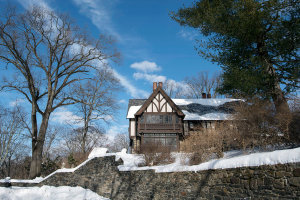Our Executive Director, Sean Sawyer, wrote a letter urging the Teatown Lake Reservation to protect The Croft, a Tudor Revival mansion built in 1913 in Westchester County, New York, for the British-born antiques dealer, Arthur Vernay. The New York Times and The Telegraph in the UK recently wrote about the fate of this unique building.
Every part of The Croft house has been salvaged from castles, estates, and houses in England, including fireplaces from the 14th century, centuries-old timbers, and a jaw-dropping carved wooden staircase.
The Teatown Lake Reservation bought the land surrounding The Croft in 2010 and plans to sell the house for $125,000, with the stipulation that the new owner must remove it from the nature preserve. Unfortunately this means the house is likely to be demolished, pieces sold off and scattered; many will end up in landfill. We urge the Teatown Lake Reservation to reconsider this decision. Preservationists are advocating for a solution which would permit the house to remain at the same spot it has for over 100 years in its original environment. We believe the historic, built and natural environments can work together, just as we’ve seen with the many wonderfully preserved houses and landscapes that the National Trust protects, and hope for a solution which can benefit all parties involved.
Dear Ms. Landau and Mr. Carter:
I write to express The Royal Oak Foundation’s deep concern regarding Teatown Lake Reservation’s announced plans to demolish and disperse Arthur Vernay’s 1913 Tudor Revival mansion, The Croft. We urge you to reconsider this plan and to preserve this historically and architecturally significant structure as a fundamental element of the reservation’s environment and mission.
As the American partner of the National Trust of England, Wales and Northern Ireland, this issue has particular resonance for us. There is the historic significance of Vernay’s work as one of the preeminent antiquities dealers of the early 20th as well as his work as a designer, knitting together important architectural fragments into a thoughtful and cohesive whole to create his residence. However, today these fragments have the greatest educational and architectural value as integral parts of his creation, not as architectural flesh once again rendered from its skeleton and put on the auction block. Indeed, today a majority of people regard the routine demolition and dispersal of significant buildings that occurred in Vernay’s time as something to be avoided at all costs. The Croft is a unique and important work of architecture that has been deemed eligible for listing on the State and National Registers of Historic Places. I would hope that this fact would speak loudly to you as conservationists.
Indeed, The Croft is an integral and essential part of Teatown and, as I see it from the perspective of the National Trust’s 120 years of work in the UK, your conservation mission. I hope you will take a broad view of what constitutes your environment and include all its aspects, natural or man-made, green or brown, historic or contemporary. In this age of the “tear-down” and “McMansion” the preservation and reuse of The Croft in situ will be an important and very visible demonstration of the conservationist ethos in practice.
All those who have brought this issue to our attention have said what a dynamic and important organization the Teatown Lake Reservation is and how central to its communities its work is. I urge you to reconsider and make The Croft, its stories and beauty, a part of the wonderful work you do.
Thank you for your attention and consideration.
Sincerely yours,

Sean E. Sawyer, Ph. D. cc. Jean-François de Lapérouse, Chairman
Executive Director Yorktown Landmark Preservation Commission





